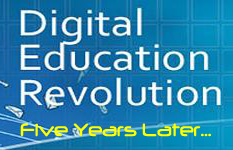by Jen Scott Curwood
 In 2008, Australia launched the $2.1 billion Digital Education Revolution. Not only did it aim to provide laptops to public high school students in years 9-12 and establish high speed broadband in all Australian schools, it also sought to develop teachers’ and students’ digital literacy skills. At the same time, Australia was working to develop and implement a national curriculum.
In 2008, Australia launched the $2.1 billion Digital Education Revolution. Not only did it aim to provide laptops to public high school students in years 9-12 and establish high speed broadband in all Australian schools, it also sought to develop teachers’ and students’ digital literacy skills. At the same time, Australia was working to develop and implement a national curriculum.
Ambitious? Yes.
Five years on, a recent program review heralds the Digital Education Revolution as a “major success” and argues that it “has achieved, or is on track to achieve, the vast majority of its objectives” (p. 5). However, annual evaluations of the project by Dr. Sarah Howard at the University of Wollongong offer a more nuanced understanding of the impact of new tools and policies in New South Wales schools.
For instance, teachers and students generally report a growing level of confidence with technology. However, students from low socioeconomic backgrounds do not share this confidence, particularly with regard to performing data manipulation and social networking tasks. Across the board, there has also been a steady decrease in students’ belief that technology enhances their learning outcomes.
As teachers have integrated more technology into their daily practices, many have reflected on their pedagogy. One teacher, for example, views the laptop as a tool that provides access to information and can aid in problem solving, adding that, “It might mean that your teaching method and teaching style has to change and maybe everybody goes towards project-based teaching and learning.”
The role of professional development in technology integration cannot be underestimated. While some teachers engaged in sustained and self-directed professional learning, others acknowledged their lack of motivation for learning about the new tools and resources. Some of this was evident in teachers’ perceptions of school leadership with regard to technology. As one teacher put it, “They support it, but I don’t think they really know how to support it.”
Where will Australia go from here? A recent report from the Digital Education Advisory Group offers some ideas.
First, since the implementation of the new Australian Curriculum will begin next year, Australian schools would substantially benefit from the development of digital resources to support students’ 21st century skills and content knowledge. Teachers, in particular, need support as they embrace inquiry-based learning and design thinking. In Australia, teachers in rural and remote areas would particularly benefit from access to high-quality online resources and online professional development.
Second, the Digital Education Advisory Group argues that digital technology can promote effective language learning. They highlight the Language Learning Space project and the Supporting the Australian Curriculum Online initiative as key examples. Another helpful resource for English teachers is the English for the Australian Curriculum website, which offers detailed lesson plans, units of work, and related resources.
For any revolution to occur, the Australian government will need to continue to invest in infrastructure as well as professional development. In many ways, effective technology integration in schools reflects a cultural change in how teachers teach and how students learn.
And after all, not all revolutions happen overnight.
 Jen Scott Curwood is a lecturer at the University of Sydney in Australia. Her website and blog are at jensc.org.
Jen Scott Curwood is a lecturer at the University of Sydney in Australia. Her website and blog are at jensc.org.